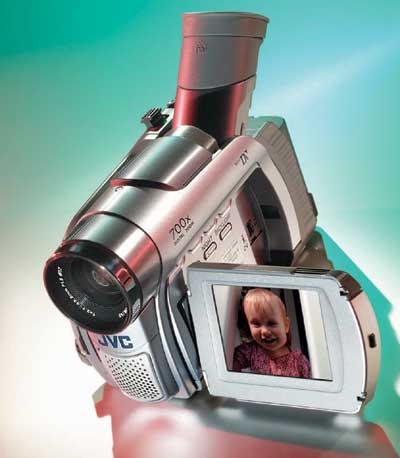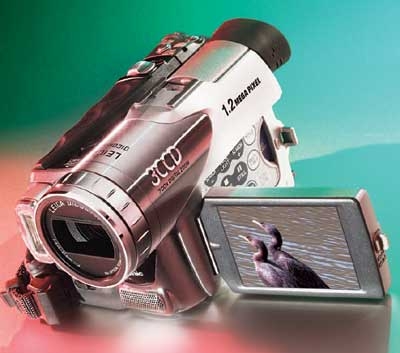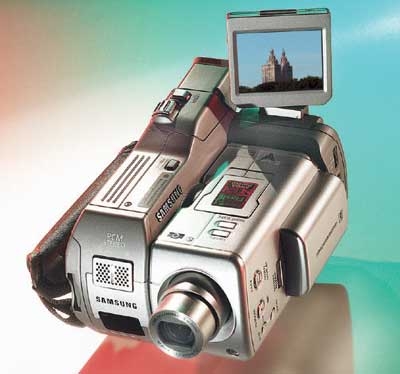A Camcorder Christmas Page 3
Feature Presentation If you're upgrading from an 8mm, Hi-8, VHS-C, or even one of those huge, ungainly VHS camcorders, you'll be happy to know that all of the cams here except the JVC offer A/V line-in recording. This is important because it lets you connect your old cam's A/V output to the new cam and make digital dubs of analog-format tapes. And if you'd like to go digital on the still-photo side without having to buy another camera, the image sensors on both the Sony and Samsung models provide enough resolution to create crisp-looking 4 x 6-inch prints (with the Samsung, you can push that to 5 x 7 or larger). Both cams also have a pop-up flash that you can use for photography, and the Sony even has a spot-metering function that lets you determine exposure by touching an area on the cam's viewscreen.
 |
| JVC GR-D30 |
| KEY FEATURES • Black-and-white viewfinder • 16x optical zoom OUTPUTS FireWire, composite- and S-video, stereo audio DIMENSIONS (WxHxD) 3 3/4 x 3 x 5 inches WEIGHT 1 1/4 pounds (without battery) PRICE $500 MANUFACTURER JVC, 1700 Valley Rd., Wayne, NJ 07470; www.jvc.com; 800-526-5308 |
Most of the cams have some type of Night mode for low-light recording. The Sony's NightShot system, however, is notable in that it lets you record scenes in total darkness by emitting a beam of infrared light from the front of the camera - the Samsung has a similar feature. NightShot drew dubious attention a few years ago when some creep claimed on the Internet that he was using it to see through women's clothing in broad daylight. In reality, however, it just makes people look like those green-faced reporters you saw on MSNBC during the war in Afghanistan, and you'll probably only find it useful for videotaping raccoons in your backyard.
Another bonus on the feature-packed Sony is its Network function. By adding an optional USB-to-standard modem or Ethernet adapter (you bring your own Internet Service Provider), you can use it to browse the Web, send and receive e-mail, or post photos or MPEG-1 video clips using the camcorder's LCD viewscreen. But a more interesting feature, in my opinion, is the Sony's 16:9 widescreen recording mode. This feature, which is also found on the Canon, lets you take advantage of the image sensor's extra resolution to record 16:9 images that you can watch on your widescreen TV. Some of the other cams also have 16:9 modes, but they simply crop the image by adding black bars at top and bottom to create a letterbox effect.
Image Is Everything Features and ergonomics are one thing, but the big surprise of this test was how different the images recorded by the various camcorders looked. The Sony and Canon cams had the best overall picture quality. The Canon delivered excellent detail in the rocks of a Central Park duck pond that I wandered past, as well as the finely textured feathers on its web-footed denizens. Its color balance also looked very natural in shots of flowers, trees, and the city skyline poking out behind them at the park's edge. The Sony, for its part, displayed very good detail and a natural-looking color balance in my shots of the park's Sheep Meadow. Here, the 16:9 recording mode worked wonders, capturing a crisp, expansive image that looked great on my widescreen TV.
 |
| PANASONIC PV-GS70 |
| KEY FEATURES • Three-CCD design • Leica Dicomar lens • MPEG-4 recording mode • Analog line-in recording • External microphone for narration INPUTS/OUTPUTS FireWire, USB 2.0, composite- and S-video, stereo audio; microphone input, headphone output DIMENSIONS (WxHxD) 3 x 2 3/4 x 5 1/4 inches WEIGHT 1 1/8 pounds (without battery) PRICE $1,000 MANUFACTURER Panasonic, One Panasonic Way, Secaucus, NJ 07094; www.panasonic.com; 800-211-7262 |
The Panasonic and Sharp cams were no slouches in the image-quality department either. Looking at my footage of a crowded plaza surrounded by a lake and trees, I was impressed at the wide range of colors the Panasonic captured, from the deep, dark green of a statue to the vivid orange in the shirts worn by a group of tourists. Aside from a greenish cast, the only complaint I had about its picture concerned sharpness, which was a definite notch below that of the Sony and Canon cams. On the other hand, Sharp's delightfully portable cam captured pictures that looked nearly as crisp as the Canon's, but its colors were slightly washed out, and skin tones had a yellow cast.
Both the JVC and Samsung cams delivered decent-looking video, but their picture sharpness was nowhere near as good as with the Canon and Sony, the top two performers in this test. Shots taken with the Samsung of the New York Public Library's famed lion statues lacked detail, although the image was pretty clean overall. The JVC's image was a bit crisper than the Samsung's, but in shots of workers raking piles of dirt on Bryant Park's lawn (the ugly aftermath of NYC's Fashion Week), the image looked grainy and the highlights were somewhat washed out.
 |
| SAMSUNG SC-D5000 |
| KEY FEATURES • Camcorder/digital camera combo • Night recording mode • MPEG-4 recording mode • Analog line-in recording INPUTS/OUTPUTS FireWire, USB 1.1, composite- and S-video, stereo audio; microphone input, headphone output DIMENSIONS (WxHxD) 3 1/4 x 3 3/4 x 5 1/2 inches WEIGHT 1 1/4 pounds (without battery) PRICE $1,400 MANUFACTURER Samsung, 105 Challenger Rd., Ridgefield Park, NJ 07660; www.samsungusa.com; 800-726-78642 |
Hitachi's DVD-cam, meanwhile, delivered good-looking images both when shooting outdoors and indoors when there was plenty of ambient light. Shadowy shots looked somewhat noisy and smeared, however, and complex scenes like Bryant Park's bubbling fountain were riddled with a fair amount of macroblock artifacts - portions of the picture were actually broken up into grids of oversized pixels. Even so, most of the footage that I captured with the Hitachi looked very good, especially my wide shot of an Abraham Lincoln impersonator leading a group of yellow-clad religious fanatics in a chorus of God Bless America. Only in New York, right?
If you do a lot of shooting indoors, a camcorder's ability to capture clear images in low-light situations will be important. The cams that I tested also varied to wide degree here, with the Sony sitting at the top of the pack. Of course, both the Sony and the Samsung's special infrared night-shooting mode lets them capture images in total darkness, which is fine if you don't mind looking at grainy pictures bathed in a sickly green glow. But in standard low-light shooting, the JVC followed the Sony in recording acceptably clear-looking pictures, with the Sharp trailing a full step behind it. The rest of the cams' low-light performance was poor, with pretty much the whole lot of them yielding images that looked pixelated, grainy, or lacking in contrast.
- Log in or register to post comments





























































